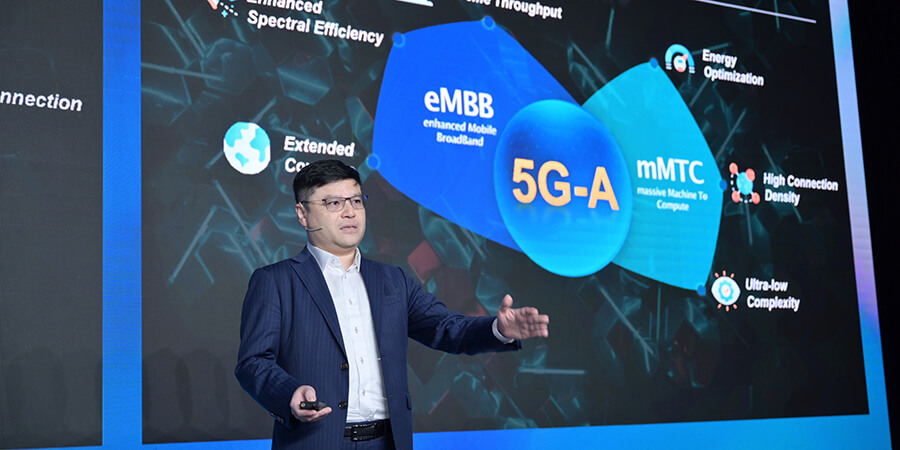With the introduction of 5G technology, the telecom industry has been racing toward a digital shift. The demand for better connectivity drives the evolution of more advanced networks. Enter 5G-Advanced, considered to be the second phase of 5G evolution, which is ready to transform connections and unleash a new wave of possibilities.
5G-Advanced, with its unprecedented speed, low latency and increased network capacity, is destined to change the way we live, work and interact with technology. Once the 3GPP's specification of 5G-Advanced is finalized, it holds the potential to revolutionize IoT by enabling seamless integration of a vast array of connected devices.
5G-Advanced networks are intended to enable a variety of useful new service capabilities, such as immersive customer solutions, enhanced private networks and fully scalable massive IoT (mMTC) devices, such as extremely low-power passive IoT devices.
At the Mobile World Congress 2023 in Shanghai, Sheldon Yau, CTO of Hong Kong Telecom (HKT), attended the 5G Futures Summit hosted by GSMA and delivered a speech on how to drive 5G-Advanced from research to deployment, sharing how HKT, a world-leading mobile network operator, has started to explore technologies for 5G-Advanced in order to improve user experience and promote the potential of 5G networks.
Exploring 5G-Advanced Applications
5G-Advanced is set to bring out the highest potential of 5G with its improved system, from extended coverage, enhanced spectral efficiency and high connection density to more precise location mapping, ultra-low latency and extreme reliability.
Industries can take advantage of 5G-Advanced to boost innovation, increase productivity and provide better services to customers. Mr. Yau showcased 5G-Advanced’s improved capabilities with the help of its next-level enhanced Mobile Broadband (eMBB), which boasts a downlink of up to 10 Gbps and an uplink of 1 Gbps.
With eMBB, HKT’s 5G networks can provide a substantial increase in data transfer rates, allowing users to experience better download and upload speeds. This enables high-definition video streaming; it is also intended to fulfill the increasing need for bandwidth-intensive applications and services while also facilitating the expansion of multimedia content consumption and developing technologies such as virtual reality (VR), augmented reality (AR) and ultra-high-definition (UHD) content.
HKT also has plans for better use of IoT through their improved mMTC, which would pave the way for a more connected and intelligent society in which objects may interact autonomously, such as in smart transportation, automated checkouts, seamless warehouse management and precise logistics control.
When it comes to Ultra-Reliable Low-Latency Communications, HKT claims that 5G-Advanced is the best “UR” yet, boasting low latency of 4 milliseconds and high reliability of 99.999, which could potentially improve medical applications, financial transactions, autonomous driving and gaming experiences.
In order to achieve the amazing possibilities of 5G-Advanced, Mr. Yau emphasizes the need for new spectrum bands with extremely wide bandwidth. The millimeter wave (mmWave) spectrum, for example, has the capacity to handle the high-speed and low-latency requirements of 5G-Advanced networks. Wide bandwidths, such as 28 GHz and higher, provide for quicker data transmission rates and improved network performance in a hotspot scenario. This increase in spectrum allocation assures that the growing demand for high-speed connections can be fulfilled, even in densely populated areas.
5G-Advanced in Hong Kong
Mr. Yau shared HKT’s remarkable success in the deployment of the 5G network. Its dedication to innovation, together with the successful rollout of 5G, has established Hong Kong as a vibrant hub for cutting-edge telecommunications. HKT has been essential in driving the deployment of 5G-Advanced networks, strengthening Hong Kong's status as a digital frontrunner.
HKT is planning to construct a 10Gbps business circle with the use of a high-speed optical fiber backhaul network, substantially improving connectivity across Hong Kong.
Meanwhile, HKT used Sub-3GHz and C-band technology while overlaying mmWave spectrum to provide a gigabit experience in indoor areas. This convergence of technology improves customer interaction and modernizes their marketing campaigns.
Additionally, by delivering an outstanding peak rate of 2.3 Gbps, which has enabled real-time immersive 3D video experiences for HKT’s customers, users can now enjoy the extraordinary depth and realism of glass-free 3D effects while doing things like taking photos and uploading them to the cloud. In the near future, HKT plans to expand the application of this full-sensory, interactive and immersive experience to holographic communication, cloud gaming and digital human scenarios.
Mr. Yau explained, “HKT is not only committed to provide extremely good network to our consumers, but we are also committed to provide extremely fast uplink and low latency network to our medical applications. By making use of millimeter wave technology, Redcap and Passive IoT devices, I truly believe we can unlock all the business potentials of 5G in the coming few years.”
HKT's outstanding success in 5G business and its bold innovation and exploration of new technology have made it a pioneer of 5.5G deployment, which reflects Hong Kong’s 5G leadership and HKT’s ongoing commitment to improving user experiences and exploring new horizons of connectivity in Hong Kong through innovative approaches and strategic deployments.





